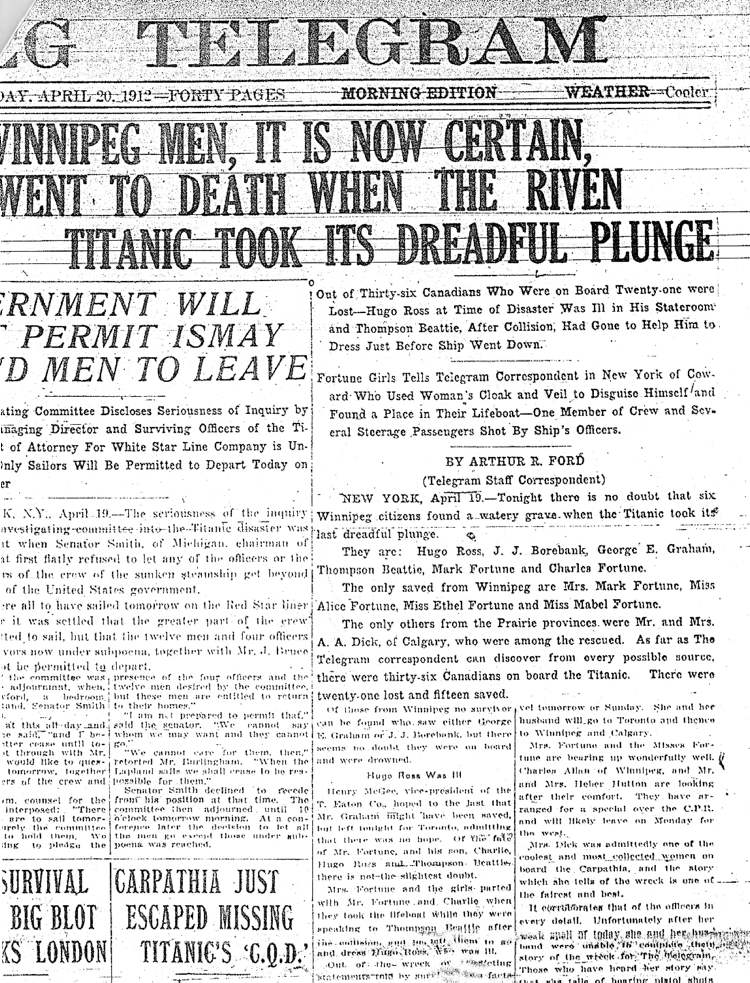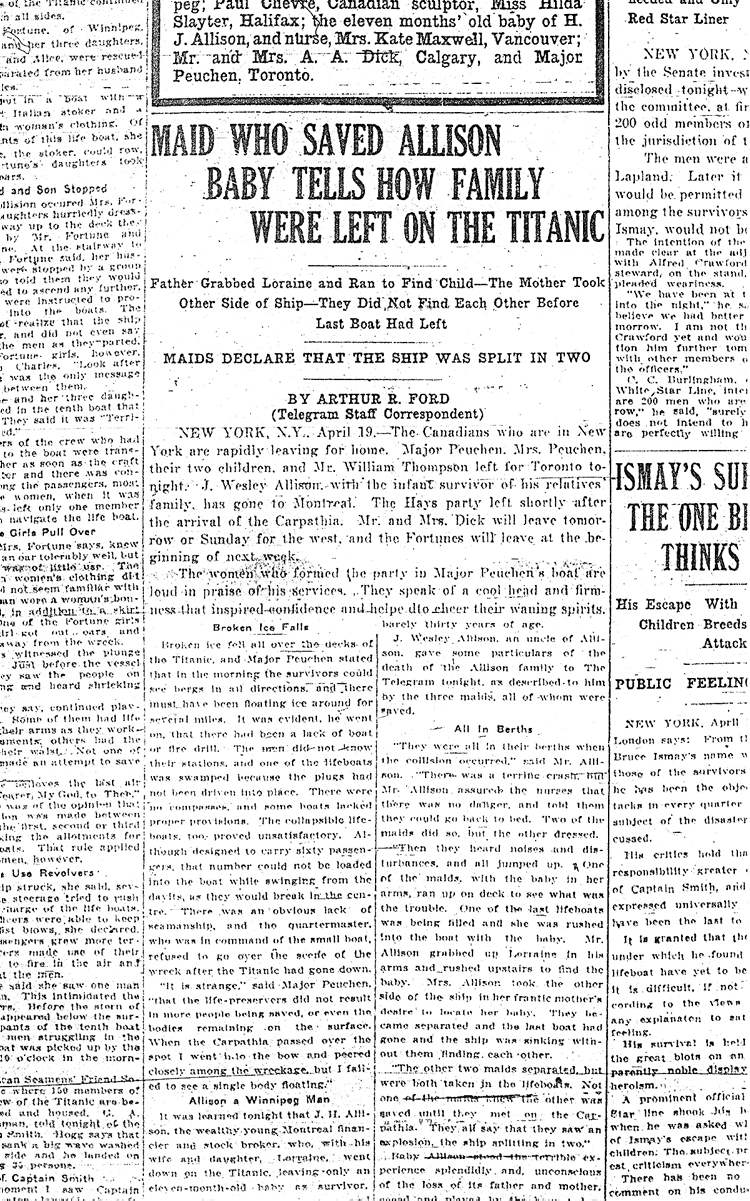Rival reporters share story of the century
Advertisement
Read this article for free:
or
Already have an account? Log in here »
To continue reading, please subscribe:
Monthly Digital Subscription
$0 for the first 4 weeks*
- Enjoy unlimited reading on winnipegfreepress.com
- Read the E-Edition, our digital replica newspaper
- Access News Break, our award-winning app
- Play interactive puzzles
*No charge for 4 weeks then price increases to the regular rate of $19.00 plus GST every four weeks. Offer available to new and qualified returning subscribers only. Cancel any time.
Monthly Digital Subscription
$4.75/week*
- Enjoy unlimited reading on winnipegfreepress.com
- Read the E-Edition, our digital replica newspaper
- Access News Break, our award-winning app
- Play interactive puzzles
*Billed as $19 plus GST every four weeks. Cancel any time.
To continue reading, please subscribe:
Add Free Press access to your Brandon Sun subscription for only an additional
$1 for the first 4 weeks*
*Your next subscription payment will increase by $1.00 and you will be charged $16.99 plus GST for four weeks. After four weeks, your payment will increase to $23.99 plus GST every four weeks.
Read unlimited articles for free today:
or
Already have an account? Log in here »
Hey there, time traveller!
This article was published 14/04/2012 (4990 days ago), so information in it may no longer be current.
Soon after the catastrophic news of the Titanic’s sinking reached the United States and Canada on April 15, 1912, a press firestorm erupted in both countries.
More than 500 North American journalists, newspapermen and women, wire service correspondents, telegraph operators and artists began to converge on New York City for the April 18 arrival of the rescue liner Carpathia and her 705 Titanic survivors.
Among the press horde sent to the east coast metropolis were 30-year-old Herbert Chisholm of the Manitoba Free Press and 26-year-old Arthur Ford of the rival Winnipeg Telegram. The account of their news coverage of the “story of the century” is both remarkable and amusing.

The race to New York
When the Titanic story broke, both Ford and Chisholm were in Ottawa covering Parliament.
Since there were several prominent Winnipeggers on board the White Star liner, they knew it would be vital to learn their fate. Early on April 18, Chisholm received instructions from his superiors in Winnipeg to secretly board a train and reach New York in time to meet Carpathia. He slipped quietly out of Ottawa, confident he would now beat Ford on the story.
However, by chance, Ford encountered a press gallery colleague who told him Chisholm had left town and the Telegram was about to “be beautifully scooped.”
Ford immediately contacted Telegram editor Mark Nichols in Winnipeg and boldly asked for funds to be wired ahead to New York. Then he rushed to Ottawa’s Union Station and caught the late afternoon express to Montreal where he boarded the New York-bound night train.
Unfortunately, he arrived too late to cover Carpathia’s arrival, so he went to the Murray Hotel where “$100 had been wired for expenses.” Next, he visited the New York Times and with the help of the paper’s managing editor discovered the surviving members of the Fortune family were in seclusion at the Belmont Hotel.
Meanwhile, before Chisholm arrived at Chelsea Pier 54, where the Carpathia was to dock at 9:30 p.m., he managed a brief dispatch to the Free Press. New Yorkers Awaited In Great Suspense shouted the headline over his lead reporting that Carpathia would dock as “a hospital ship.”
Although present when Titanic’s survivors disembarked, there was so much confusion at Cunard’s docking sheds that Chisholm could not learn the fate of the Winnipeg passengers other than Mrs. Fortune and her three daughters were safe at the Belmont.
No use cutting each other’s throats
What happened next was lucky for both Winnipeg reporters.
Just before midnight, Ford was on his way to the Belmont to interview the Fortune women.
“I was hurrying down 42nd Street,” he later recalled, “when of all people, I ran plump into Chisholm. He was the most astounded man in the world. We started a play of wits, and finally he said to me: ‘Arthur, what is the use of cutting each other’s throats? Let us work together.’ ” Ford quickly agreed and for the next two days they worked as “partners,” giving Winnipeg readers desperately needed news.
On April 19, the Telegram ran several stories by Ford. In one, headlined Winnipeg Men, It Is Now Certain, Went To Death When The Riven Titanic Took Its Fateful Plunge, he confirmed Mark and Charles Fortune, Borebank, Graham, Beattie and Ross were lost when the Titanic foundered, but Albert and Vera Dick had survived.

In another report he contributed, perhaps unwittingly, to one of the most famous Titanic controversies: What was the last song played by the orchestra? In Moving Story Of Disaster Told By Fortune Family, Ford reported the Fortune women praising the sinking ship’s bandsmen who were “wonderfully heroic, they never flinched, thought nothing of self and played until the last piece, the Christian hymn ‘Nearer, My God, to Thee.’ “
Not to be outdone, Chisholm provided Free Press readers a riveting interview with the fortunate newlyweds Albert and Vera Dick. In Calgary Man Was Pushed Into Boat, Chisholm had Albert describe how he was saved by his young bride. “Our boat was the sixth, and there were few women by the rail, which was lowered away. Mrs. Dick came forward and they started pulling her to the boat and away from me. She did not want to go without me, but I took her to the rail and kissed her goodbye. Then an officer shoved me on board, and we were lowered away.”
Although Albert’s account of events was likely accurate, upon returning to Calgary, he was considered a coward and even rumoured to have dressed as a woman to enter a lifeboat.
A job well done
After their final reports were wired to Winnipeg, Chisholm and Ford took another day off and spent the rest of their funds seeing the sights of New York, satisfied they had the opportunity of covering one of the greatest stories of all time.
Herbert Chisholm and Arthur Ford
Herbert Eustace Maxwell Chisholm was a Scot who came to Canada as a child. Under the tutelage of John Dafoe, he rose through the ranks of the Free Press to become the paper’s city editor and then parliamentary correspondent in Ottawa. In 1926, Chisholm transferred to the federal government’s Department of Trade and Commerce and from 1940 to 1945 was the organization’s director of publicity.
Arthur Ford joined the Winnipeg Telegram in 1911 and was immediately assigned to Ottawa as the paper’s parliamentary correspondent. He would later write for the Ottawa Journal, Toronto Times and London Free Press where he was successively managing editor, editor-in-chief and editor emeritus. Ford would help found the University of Western Ontario’s School of Journalism.




